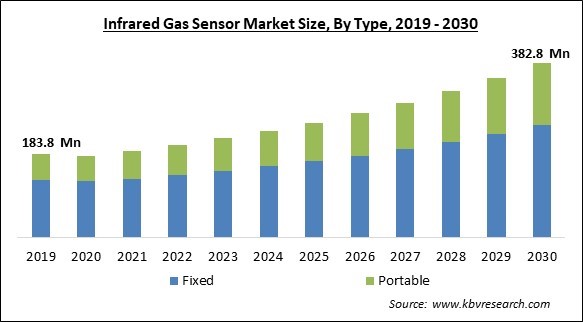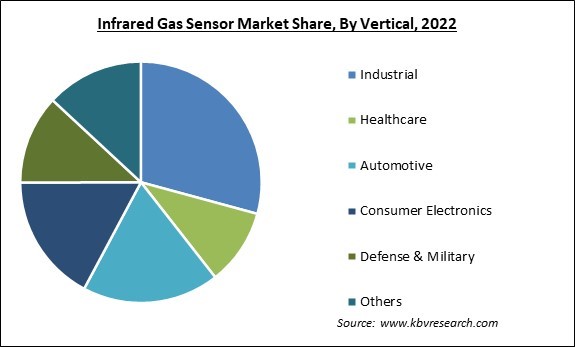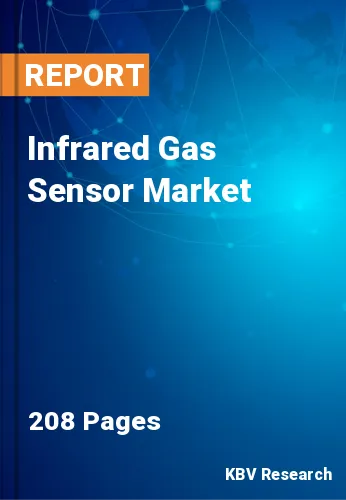The Global Infrared Gas Sensor Market size is expected to reach $382.8 million by 2030, rising at a market growth of 8.4% CAGR during the forecast period.
Infrared gas sensors are often used nowadays in appliances such as ovens, stoves, and water heaters to monitor and regulate combustion processes. Consequently, Consumer Electronics segment registered $34,970.2 thousands revenue in the market in 2022. Real-time indoor air quality monitoring is made possible by integrating these sensors into consumer goods like air purifiers and smart home systems. Users may get notifications and take action to enhance the air quality in their living areas. By precisely monitoring gas levels, these sensors allow efficient fuel use, resulting in energy savings and less emissions. Some of the factors impacting the market are rising demand for temperature monitoring and control in industrial sector, utilizing the Internet of Things (IoT) to Network to Generate Profitable Opportunities, and expensive infrared gas sensors.

Methane, propane, ethane, butane, benzene toluene, xylene, and other gases, as well as various alcohols such as methanol and ethanol, are all detectable using infrared gas sensors. Infrared oxygen sensors are used for a variety of purposes, ranging from home to industrial. The installation of gas sensors can be used for a variety of purposes, such as the monitoring of chemical reactions, combustion engine emissions, and air pollution. The Internet of Things is the primary driver of several critical technical advancements. Modern businesses employ IoT apps and sensors for various purposes, from improving supply chains and manufacturing procedures to assisting local government growth via the usage of smart cities. IoT offers several advantages and helps businesses monitor complicated operations, including time and money savings, enhanced customer satisfaction, support for strategic decision-making, simplified business models, and increased productivity. Because they increase demand for NADIR gas sensors across various industry verticals, including the automotive, industrial, and other industries, the factors mentioned above help the market for these sensors grow.
However, in harsh conditions, infrared gas sensors have limited performance. These sensors are unable to provide sufficient temperature and environmental correction. The signal processing function of the sensor may cause any output measurement to be frozen while traversing situations with even mild variations in temperature or humidity. Additionally, it cannot detect hydrogen, and several hydrocarbon-based gases impair the performance of infrared gas sensors. Infrared light is not absorbed by hydrogen. These sensors cannot detect hydrogen. However, the high cost of the equipment and the need for more user skills are anticipated to limit the development of the market to some degree.
By industry vertical, the market is divided into healthcare, consumer electronics, automotive, industrial, defense & military, and other. The industrial segment dominated the market with the maximum revenue share. This results from widespread usage in industrial end-use for flammable gas leak detection for safety and security. The industry's use of IoT, AI, and machine learning drives the market.

Based on type, the market is segmented into fixed and portable. The portable segment garnered a significant revenue share in the market in 2022. They have advantages, including detection over a wider region, quick reactions to change, and danger level indication. Additionally, the adoption of industrial IoT technology, cloud computing in the mining and construction sectors, and expansion in the e-commerce sector are driving the development of the market.
| Report Attribute | Details |
|---|---|
| Market size value in 2022 | USD 203.8 Million |
| Market size forecast in 2030 | USD 382.8 Million |
| Base Year | 2022 |
| Historical Period | 2019 to 2021 |
| Forecast Period | 2023 to 2030 |
| Revenue Growth Rate | CAGR of 8.4% from 2023 to 2030 |
| Number of Pages | 208 |
| Number of Table | 280 |
| Report coverage | Market Trends, Revenue Estimation and Forecast, Segmentation Analysis, Regional and Country Breakdown, Companies Strategic Developments, Company Profiling |
| Segments covered | Type, Vertical, Region |
| Country scope | US, Canada, Mexico, Germany, UK, France, Russia, Spain, Italy, China, Japan, India, South Korea, Singapore, Malaysia, Brazil, Argentina, UAE, Saudi Arabia, South Africa, Nigeria |
| Growth Drivers |
|
| Restraints |
|
Region wise, the market is analysed across North America, Europe, Asia Pacific and LAMEA. The North American region led the market by generating the highest revenue share in 2022. The main trends driving the expansion of the North American market are the development of wireless capabilities, miniaturization, and increased communication capabilities. The US is anticipated to become a key infrared gas sensor industry market. These characteristics allow for the integration of infrared gas sensors into a variety of machinery and apparatus. Additionally, several legislative measures in North America's developed markets to promote employee occupational health and safety are anticipated to fuel market expansion throughout the projected period.
Free Valuable Insights: Global Infrared Gas Sensor Market size to reach USD 382.8 Million by 2030
The market research report covers the analysis of key stake holders of the market. Key companies profiled in the report include Heimann Sensor GmbH, Amphenol Corporation, smartGAS Mikrosensorik GmbH, Alphasense Ltd (Ametek, Inc.), ABB Group, Senseair AB (Asahi Kasei Corporation), Process Sensing Technologies, Honeywell International, Inc., Dragerwerk AG & Co. KGaA, and Figaro Engineering, Inc. (New Cosmos Electric Co., Ltd.).
By Type
By Vertical
By Geography
The Market size is projected to reach USD 382.8 million by 2030.
utilizing the Internet of Things (IoT) to Network to Generate Profitable Opportunities are driving the Market in coming years, however, expensive infrared gas sensors restraints the growth of the Market.
Heimann Sensor GmbH, Amphenol Corporation, smartGAS Mikrosensorik GmbH, Alphasense Ltd (Ametek, Inc.), ABB Group, Senseair AB (Asahi Kasei Corporation), Process Sensing Technologies, Honeywell International, Inc., Dragerwerk AG & Co. KGaA, and Figaro Engineering, Inc. (New Cosmos Electric Co., Ltd.).
The expected CAGR of this Market is 8.4% from 2023 to 2030.
The Fixed segment is leading the Market by Type in 2022 and would continue to be a dominant market till 2030; thereby, achieving a market value of $246.5 million by 2030.
The Asia Pacific region dominated the Market by Region in 2022, and would continue to be a dominant market till 2030; thereby, achieving a market value of $155 million by 2030.
Our team of dedicated experts can provide you with attractive expansion opportunities for your business.

